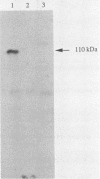Abstract
The genetic and antigenic relatedness of eight antigens in three strains of Rickettsia tsutsugamushi has been studied by using recombinant organisms expressing epitopes of the 150-, 110-, 72-, 58-, 56-, 49-, 47-, and 20-kilodalton (kDa) polypeptide antigens of the Karp strain. Southern blot analysis of Karp, Kato, and Gilliam strain genomic DNA by using probes specific for each antigen class indicated that while strong homology exists between each of the corresponding antigen genes in these three strains, some restriction fragment length polymorphism exists. Antibodies affinity purified against each recombinant antigen class reacted with a comparably sized polypeptide in the Karp, Kato, and Gilliam strains in Western blots (immunoblots). Against more recent human isolates of R. tsutsugamushi, the affinity-purified antibodies against the 58-kDa recombinant antigen (anti-58-kDa) reacted with all nine isolates, anti-56-kDa reacted with eight of nine isolates, anti-47-kDa reacted with eight of nine isolates, anti-72-kDa reacted with eight of nine isolates, and anti-110-kDa reacted with four of nine isolates. Additional analysis indicated that the 110-kDa antigen may contain strain-specific epitopes similar to those previously reported for the 56-kDa polypeptide. Evidently, the strain heterogeneity among scrub typhus rickettsiae is a result of multiple components that exhibit variability in a background of strong homology.
Full text
PDF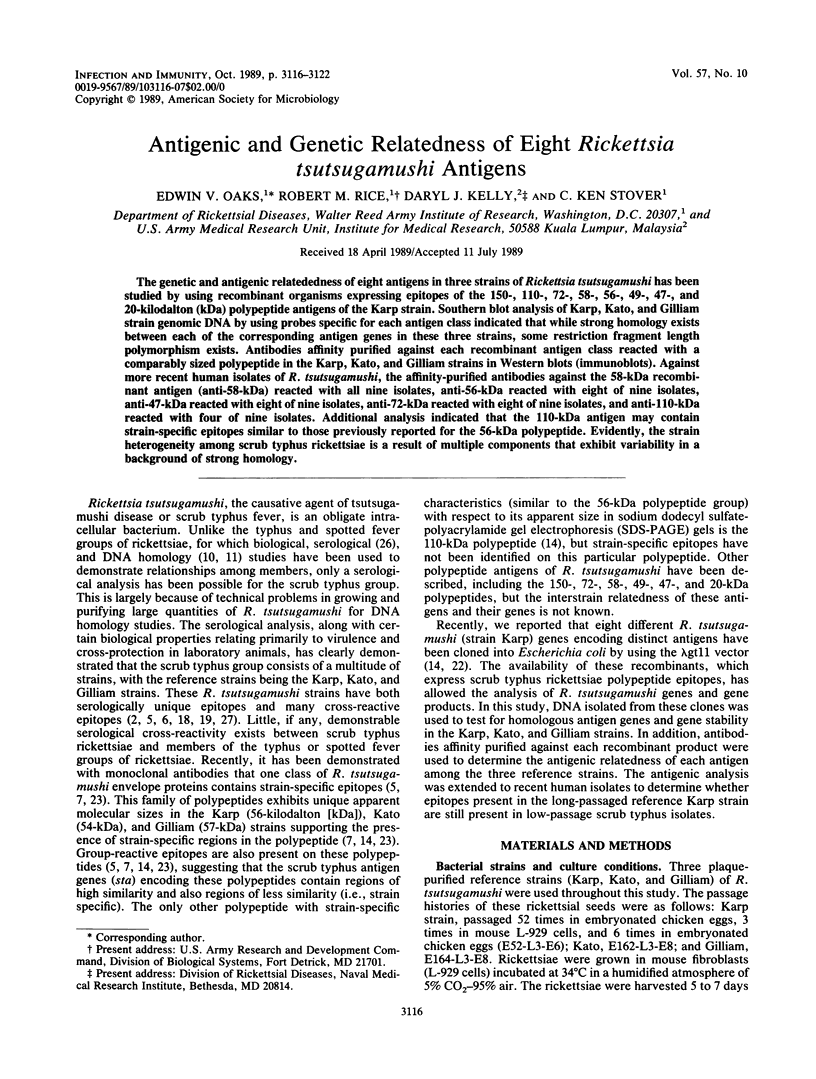

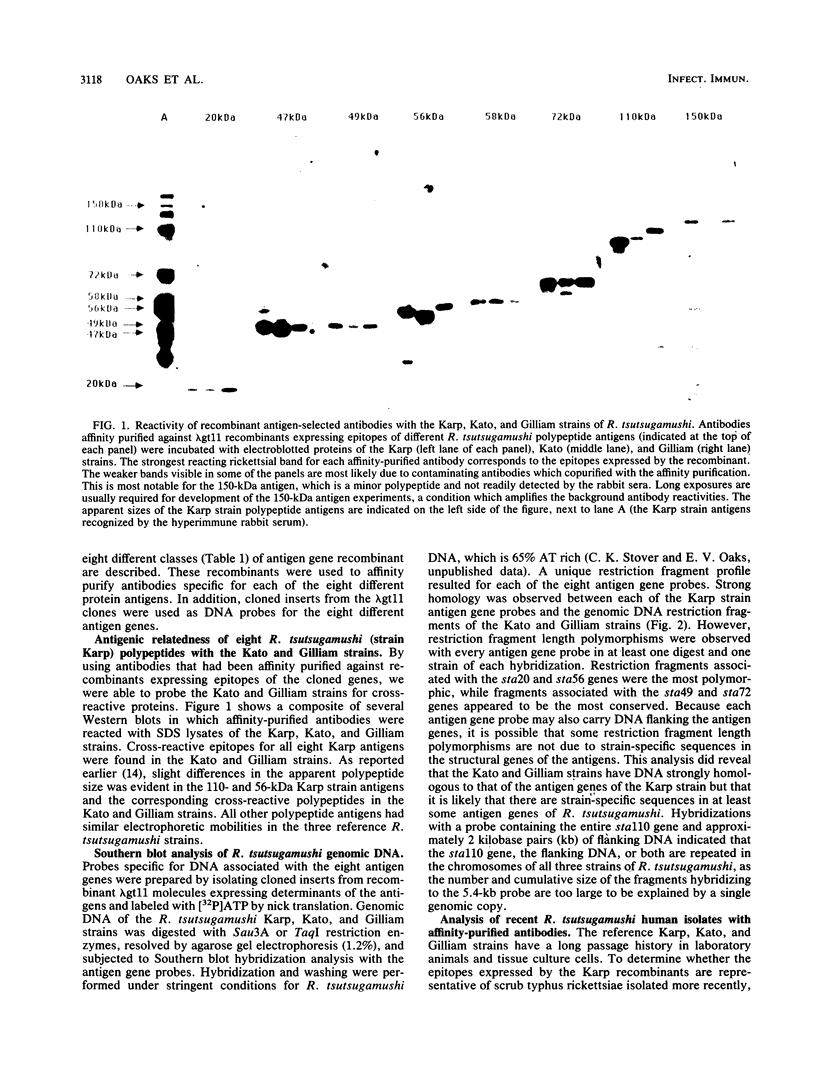
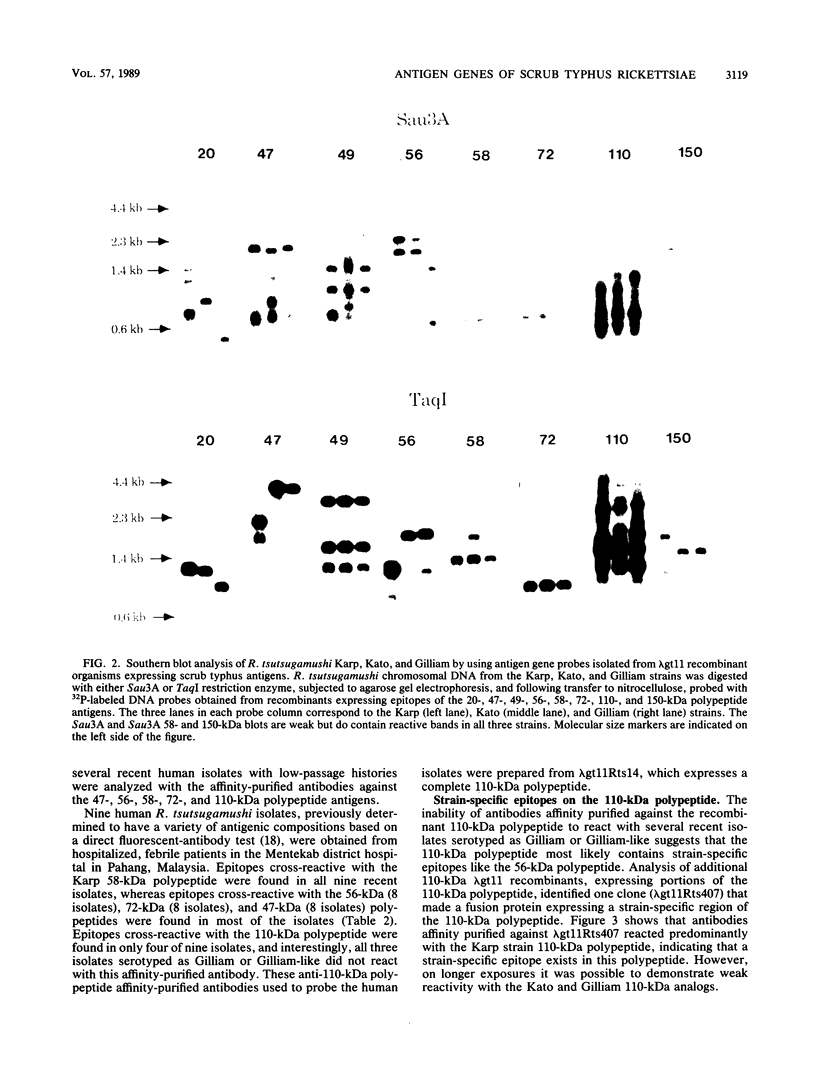
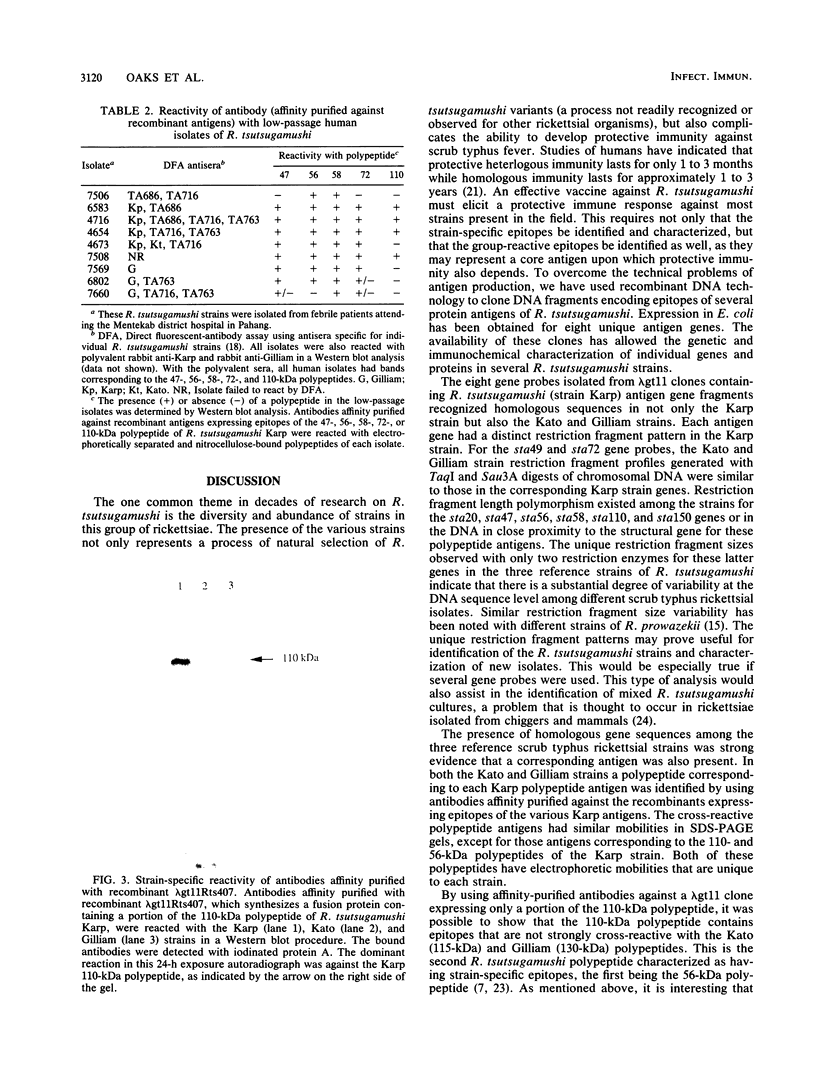
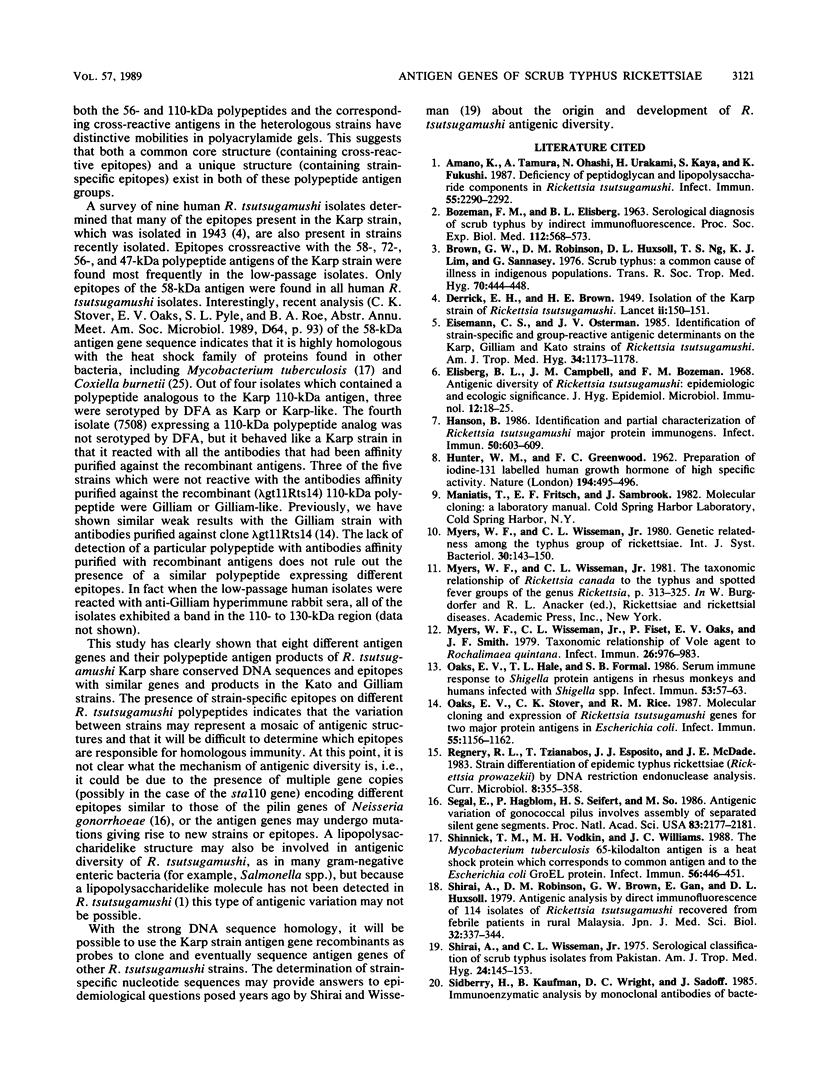
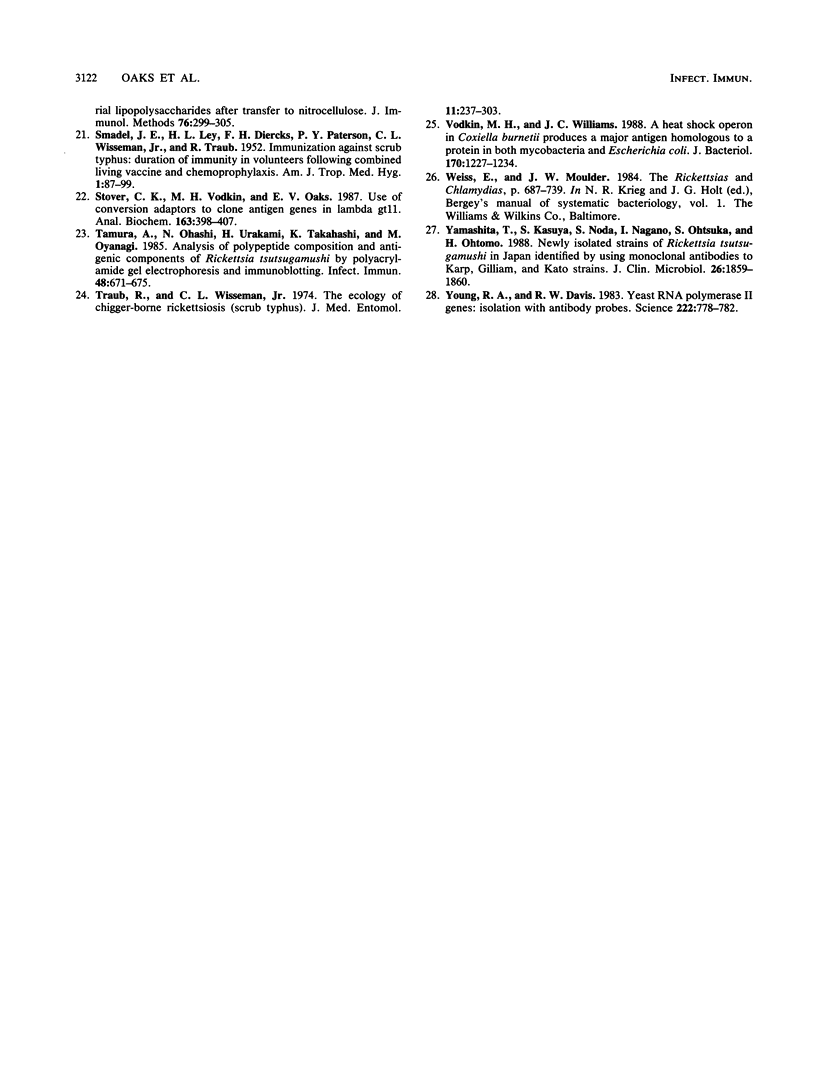
Images in this article
Selected References
These references are in PubMed. This may not be the complete list of references from this article.
- Amano K., Tamura A., Ohashi N., Urakami H., Kaya S., Fukushi K. Deficiency of peptidoglycan and lipopolysaccharide components in Rickettsia tsutsugamushi. Infect Immun. 1987 Sep;55(9):2290–2292. doi: 10.1128/iai.55.9.2290-2292.1987. [DOI] [PMC free article] [PubMed] [Google Scholar]
- BOZEMAN F. M., ELISBERG B. L. Serological diagnosis of scrub typhus by indirect immunofluorescence. Proc Soc Exp Biol Med. 1963 Mar;112:568–573. doi: 10.3181/00379727-112-28107. [DOI] [PubMed] [Google Scholar]
- Brown G. W., Robinson D. M., Huxsoll D. L., Ng T. S., Lim K. J. Scrub typhus: a common cause of illness in indigenous populations. Trans R Soc Trop Med Hyg. 1976;70(5-6):444–448. doi: 10.1016/0035-9203(76)90127-9. [DOI] [PubMed] [Google Scholar]
- Eisemann C. S., Osterman J. V. Identification of strain-specific and group-reactive antigenic determinants on the Karp, Gilliam and Kato strains of Rickettsia tsutsugamushi. Am J Trop Med Hyg. 1985 Nov;34(6):1173–1178. doi: 10.4269/ajtmh.1985.34.1173. [DOI] [PubMed] [Google Scholar]
- Elisberg B. L., Campbell J. M., Bozeman F. M. Antigenic diversity of rickettsia tsutsugamushi: epidemiologic and ecologic significance. J Hyg Epidemiol Microbiol Immunol. 1968;12(1):18–25. [PubMed] [Google Scholar]
- HUNTER W. M., GREENWOOD F. C. Preparation of iodine-131 labelled human growth hormone of high specific activity. Nature. 1962 May 5;194:495–496. doi: 10.1038/194495a0. [DOI] [PubMed] [Google Scholar]
- Hanson B. Identification and partial characterization of Rickettsia tsutsugamushi major protein immunogens. Infect Immun. 1985 Dec;50(3):603–609. doi: 10.1128/iai.50.3.603-609.1985. [DOI] [PMC free article] [PubMed] [Google Scholar]
- Myers W. F., Wisseman C. L., Jr, Fiset P., Oaks E. V., Smith J. F. Taxonomic relationship of vole agent to Rochalimaea quintana. Infect Immun. 1979 Dec;26(3):976–983. doi: 10.1128/iai.26.3.976-983.1979. [DOI] [PMC free article] [PubMed] [Google Scholar]
- Oaks E. V., Hale T. L., Formal S. B. Serum immune response to Shigella protein antigens in rhesus monkeys and humans infected with Shigella spp. Infect Immun. 1986 Jul;53(1):57–63. doi: 10.1128/iai.53.1.57-63.1986. [DOI] [PMC free article] [PubMed] [Google Scholar]
- Oaks E. V., Stover C. K., Rice R. M. Molecular cloning and expression of Rickettsia tsutsugamushi genes for two major protein antigens in Escherichia coli. Infect Immun. 1987 May;55(5):1156–1162. doi: 10.1128/iai.55.5.1156-1162.1987. [DOI] [PMC free article] [PubMed] [Google Scholar]
- SMADEL J. E., LEY H. L., Jr, DIERCKS F. H., PATERSON P. Y., WISSEMAN C. L., Jr, TRAUB R. Immunization against scrub typhus: duration of immunity in volunteers following combined living vaccine and chemoprophylaxis. Am J Trop Med Hyg. 1952 Jan;1(1):87–99. doi: 10.4269/ajtmh.1952.1.87. [DOI] [PubMed] [Google Scholar]
- Segal E., Hagblom P., Seifert H. S., So M. Antigenic variation of gonococcal pilus involves assembly of separated silent gene segments. Proc Natl Acad Sci U S A. 1986 Apr;83(7):2177–2181. doi: 10.1073/pnas.83.7.2177. [DOI] [PMC free article] [PubMed] [Google Scholar]
- Shinnick T. M., Vodkin M. H., Williams J. C. The Mycobacterium tuberculosis 65-kilodalton antigen is a heat shock protein which corresponds to common antigen and to the Escherichia coli GroEL protein. Infect Immun. 1988 Feb;56(2):446–451. doi: 10.1128/iai.56.2.446-451.1988. [DOI] [PMC free article] [PubMed] [Google Scholar]
- Shirai A., Robinson D. M., Brown G. W., Gan E., Huxsoll D. L. Antigenic analysis by direct immunofluorescence of 114 isolates of Rickettsia tsutsugamushi recovered from febrile patients in rural Malaysia. Jpn J Med Sci Biol. 1979 Dec;32(6):337–344. doi: 10.7883/yoken1952.32.337. [DOI] [PubMed] [Google Scholar]
- Shirai A., Wisseman C. L., Jr Serologic classification of scrub typhus isolates from Pakistan. Am J Trop Med Hyg. 1975 Jan;24(1):145–153. doi: 10.4269/ajtmh.1975.24.145. [DOI] [PubMed] [Google Scholar]
- Stover C. K., Vodkin M. H., Oaks E. V. Use of conversion adaptors to clone antigen genes in lambda gt11. Anal Biochem. 1987 Jun;163(2):398–407. doi: 10.1016/0003-2697(87)90241-7. [DOI] [PubMed] [Google Scholar]
- Tamura A., Ohashi N., Urakami H., Takahashi K., Oyanagi M. Analysis of polypeptide composition and antigenic components of Rickettsia tsutsugamushi by polyacrylamide gel electrophoresis and immunoblotting. Infect Immun. 1985 Jun;48(3):671–675. doi: 10.1128/iai.48.3.671-675.1985. [DOI] [PMC free article] [PubMed] [Google Scholar]
- Traub R., Wisseman C. L., Jr The ecology of chigger-borne rickettsiosis (scrub typhus). J Med Entomol. 1974 Jul 15;11(3):237–303. doi: 10.1093/jmedent/11.3.237. [DOI] [PubMed] [Google Scholar]
- Vodkin M. H., Williams J. C. A heat shock operon in Coxiella burnetti produces a major antigen homologous to a protein in both mycobacteria and Escherichia coli. J Bacteriol. 1988 Mar;170(3):1227–1234. doi: 10.1128/jb.170.3.1227-1234.1988. [DOI] [PMC free article] [PubMed] [Google Scholar]
- Yamashita T., Kasuya S., Noda S., Nagano I., Ohtsuka S., Ohtomo H. Newly isolated strains of Rickettsia tsutsugamushi in Japan identified by using monoclonal antibodies to Karp, Gilliam, and Kato strains. J Clin Microbiol. 1988 Sep;26(9):1859–1860. doi: 10.1128/jcm.26.9.1859-1860.1988. [DOI] [PMC free article] [PubMed] [Google Scholar]
- Young R. A., Davis R. W. Yeast RNA polymerase II genes: isolation with antibody probes. Science. 1983 Nov 18;222(4625):778–782. doi: 10.1126/science.6356359. [DOI] [PubMed] [Google Scholar]





